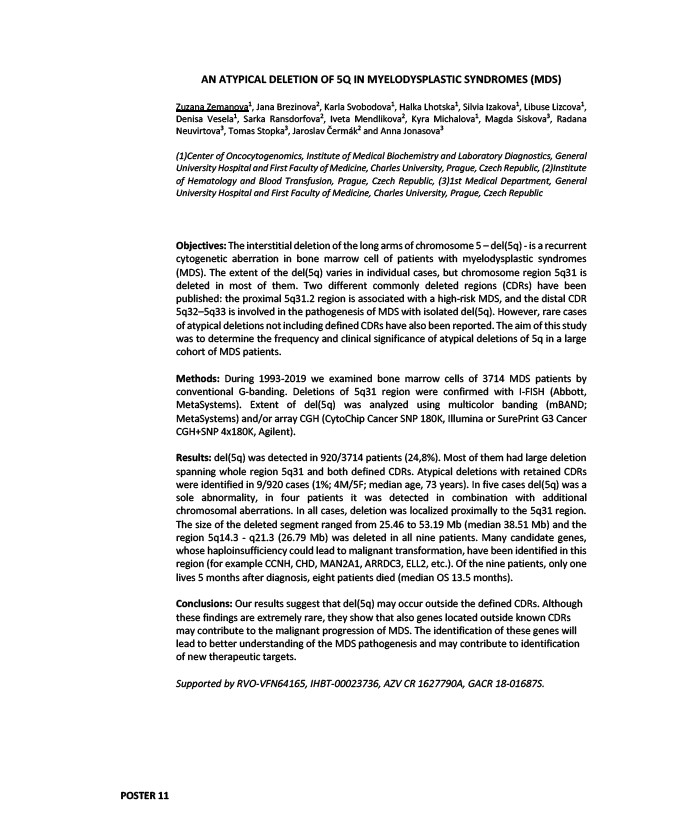
AN ATYPICAL DELETION OF 5Q IN MYELODYSPLASTIC SYNDROMES (MDS)
Zuzana Zemanova1, Jana Brezinova2, Karla Svobodova1, Halka Lhotska1, Silvia Izakova1, Libuse Lizcova1,
Denisa Vesela1, Sarka Ransdorfova2, Iveta Mendlikova2, Kyra Michalova1, Magda Siskova3, Radana
Neuvirtova3, Tomas Stopka3, Jaroslav Čermák2 and Anna Jonasova3
(1)Center of Oncocytogenomics, Institute of Medical Biochemistry and Laboratory Diagnostics, General
University Hospital and First Faculty of Medicine, Charles University, Prague, Czech Republic, (2)Institute
of Hematology and Blood Transfusion, Prague, Czech Republic, (3)1st Medical Department, General
University Hospital and First Faculty of Medicine, Charles University, Prague, Czech Republic
Objectives: The interstitial deletion of the long arms of chromosome 5 – del(5q) - is a recurrent
cytogenetic aberration in bone marrow cell of patients with myelodysplastic syndromes
(MDS). The extent of the del(5q) varies in individual cases, but chromosome region 5q31 is
deleted in most of them. Two different commonly deleted regions (CDRs) have been
published: the proximal 5q31.2 region is associated with a high-risk MDS, and the distal CDR
5q32–5q33 is involved in the pathogenesis of MDS with isolated del(5q). However, rare cases
of atypical deletions not including defined CDRs have also been reported. The aim of this study
was to determine the frequency and clinical significance of atypical deletions of 5q in a large
cohort of MDS patients.
Methods: During 1993-2019 we examined bone marrow cells of 3714 MDS patients by
conventional G-banding. Deletions of 5q31 region were confirmed with I-FISH (Abbott,
MetaSystems). Extent of del(5q) was analyzed using multicolor banding (mBAND;
MetaSystems) and/or array CGH (CytoChip Cancer SNP 180K, Illumina or SurePrint G3 Cancer
CGH+SNP 4x180K, Agilent).
Results: del(5q) was detected in 920/3714 patients (24,8%). Most of them had large deletion
spanning whole region 5q31 and both defined CDRs. Atypical deletions with retained CDRs
were identified in 9/920 cases (1%; 4M/5F; median age, 73 years). In five cases del(5q) was a
sole abnormality, in four patients it was detected in combination with additional
chromosomal aberrations. In all cases, deletion was localized proximally to the 5q31 region.
The size of the deleted segment ranged from 25.46 to 53.19 Mb (median 38.51 Mb) and the
region 5q14.3 - q21.3 (26.79 Mb) was deleted in all nine patients. Many candidate genes,
whose haploinsufficiency could lead to malignant transformation, have been identified in this
region (for example CCNH, CHD, MAN2A1, ARRDC3, ELL2, etc.). Of the nine patients, only one
lives 5 months after diagnosis, eight patients died (median OS 13.5 months).
Conclusions: Our results suggest that del(5q) may occur outside the defined CDRs. Although
these findings are extremely rare, they show that also genes located outside known CDRs
may contribute to the malignant progression of MDS. The identification of these genes will
lead to better understanding of the MDS pathogenesis and may contribute to identification
of new therapeutic targets.
Supported by RVO-VFN64165, IHBT-00023736, AZV CR 1627790A, GACR 18-01687S.
POSTER 11